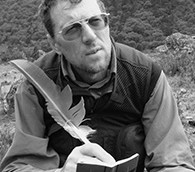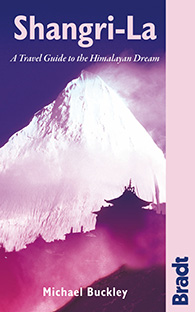Interview with Michael Buckley: Searching for Shangri-La
Travel Interviews: Frank Bures talks to the author of a guide to a place that may or may not exist
01.15.09 | 9:09 AM ET
 Few places have gripped the world’s imagination like Shangri-La, the setting of James Hilton’s 1933 novel, Lost Horizon. The book’s hero, Hugh Conway, survives a plane crash in the Himalayas and ends up in a strange and far off land, where people don’t age, the library has 30,000 books, spiritual harmony abounds and everyone has bathtubs from Akron, Ohio. Since the book’s publication, travelers and writers have been trying to figure out if Shangri-La or the inspiration for Shangri-La really exists, or if we just want it to exist.
Few places have gripped the world’s imagination like Shangri-La, the setting of James Hilton’s 1933 novel, Lost Horizon. The book’s hero, Hugh Conway, survives a plane crash in the Himalayas and ends up in a strange and far off land, where people don’t age, the library has 30,000 books, spiritual harmony abounds and everyone has bathtubs from Akron, Ohio. Since the book’s publication, travelers and writers have been trying to figure out if Shangri-La or the inspiration for Shangri-La really exists, or if we just want it to exist.
Now, Michael Buckley has written a guide not just to the region where Shangri-La may or may not be, but also to the novel, the myth and the ongoing quest for a paradise that remains pure and beautiful and good. “Shangri-La: A Travel Guide to the Himalayan Dream,” also serves as a first-rate guide to the places in Bhutan, Nepal, Tibet, India and China considered possible locations that inspired Shangri-La. I asked Buckley via email about mythomania, the lure of the mountain paradise and what we’re really looking for when we look for Shangri-La.
World Hum: Apart from the satires, I’ve never seen a guidebook about a place that doesn’t exist. What prompted you to write this one?
Michael Buckley: There are a number of guidebooks to realms that may or may not exist—all the way from Dante’s “Inferno” to recent guidebooks to the “Da Vinci Code.” I mention those two because they have spiritual angles. Spiritual guidebooks you might call them. In Tibetan literature there are a number of guidebooks to Shambhala. I think the Shangri-La guidebook fits into this genre. There are a number of reasons for writing this guidebook—as a new way of looking at Tibetan culture in the Himalayas, and to examine the various claims made about discovery of the real Shangri-La.
You quote André Malraux as saying, “Every adventurer starts out as a mythomanic.” What does he mean by that?
We develop romantic visions about certain travel destinations based on stories that may or may not be true. If I say the word “Tahiti,” doesn’t that bring up “Mutiny on the Bounty” and all the imagery that goes with it? And for the sailors on the Bounty, Tahiti was paradise. Based on a true story, too, though details were fictionalized. Movies and books about certain places inspire us, drive our dreams, turn destinations into passions. That’s what Malraux is saying. James Hilton’s “Lost Horizon” has inspired scores of people to go and visit the Himalayas (myself among them), and yet the author never set foot in Tibet (he never set foot in Asia).
Why do you think the myth of Shangri-La has had such a grip on the Western imagination?
The legend of Shangri-La came out in 1933—a period of great unrest. The world was in the aftermath of the Great Depression, which saw the Wall Street crash that bankrupted many. The clouds of war were hanging over Europe and Asia—Germany saw the rise of Hitler and the Nazi party, while the military power of Japan was running amok in China. These were highly turbulent times. And I venture to suggest that the situation today is not greatly different: we have worldwide economic chaos happening, we have clouds of war hanging over Afghanistan, Iraq and a number of other hot spots.
Shangri-La is the ultimate escape from all this—it presents a place where peace and harmony reign, where spiritualism and contentment abound. We want to believe there is a place where all this is possible. Humans are utopia-seekers, and Shangri-La presents a crystal vision of a Himalayan utopia.
I understand the Chinese actually renamed an area “Shangri-La County” in 2002?
Yes, Shangri-La County is shown on a map in the guidebook, and that’s what got this guidebook started—the fact that Chinese authorities laid claim to the real location for Shangri-La. The claim is spurious at best. I wanted to present a wider range of candidates across the Himalayas.
 You come down hard on a lot of writers for their faux quests for Shangri-La. What’s the problem with that?
You come down hard on a lot of writers for their faux quests for Shangri-La. What’s the problem with that?
Poor research, in a nutshell. There are some very flaky accounts out there where the research is all scrambled up. The Chinese authorities, for instance, base their claims on the writings of American botanist Joseph Rock for National Geographic. But Joseph Rock never wrote up the regions of Zhongdian or Deqin in National Geographic stories before “Lost Horizon” appeared (1933). He wrote about those places in a voluminous and obscure book that appeared in 1947. Ian Baker and Michael McCrae advance very strange claims to try and link the jungle region of Pemako to Shangri-La, and McCrae even informs us that there is an abyss of contradictions between the two. This is all packaging: Shangri-La is a well-known name, while Pemako is not. If they were presenting all this in a fictional work, that would be fine, but they are harping on this in a work of exploration, which doesn’t jibe.
What are people really looking for when they look for Shangri-La?
I think they are looking for exactly what the protagonist of “Lost Horizon” was looking for. Conway, the key character, is burned out after fighting in WWI. At Shangri-La he discovers what he has been longing for all his life: a philosophy, a spiritual dimension, a chance to pursue his interests without a time limit. This is an altered vision of time—and one that is supremely seductive: the fact that time moves slowly there, without physical decay.
You say you’ve spent over 20 years exploring the Himalayan region where Hilton set his book. What has been the allure of the place for you?
Speaking about the passage of time, 20 years is a long time!
I live in B.C., Canada. We have great coastal mountains here with great snow. But when you go to the Himalayas, the scale is entirely different. The sheer scale of the peaks of the Himalayas is breathtaking—being in the presence of the highest peaks on Earth is something special. But there’s more: those mountains inspire spirituality, with Tibetans being among the most devout people on the planet. What keeps me going back is the special nature of the Tibetans—who appear near-mythical to me because their logic appears to run counter to everything in the West. They are not so interested in money, for instance. They are more keen on spiritual objectives.
So how do we know you haven’t secretly found Shangri-La and are just covering your tracks with a guidebook?
Ah, but I have found it! Or let’s call that traces of Shangri-La. You can find, in the Himalayas, the key elements of Shangri-La: majestic snowcaps, majestic monasteries, High Lamas and deep spirituality. It’s just that you won’t find all these elements in the one place. The High Lamas of Tibet are in exile, mostly living in India. Spirituality is the key to Shangri-La. James Hilton put everything in one place—the big snow-capped peak, fertile valley of the Blue Moon, the High Lama, the special community of Shangri-La and the lamasery of Shangri-La. There are definite “Shangri-La moments” while traveling in the Himalayas—in Nepal, Tibet or Bhutan. That’s more what I would define it as—Shangri-La moments, fleeting glimpses of the Himalayan utopia.![]()